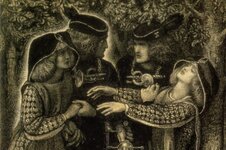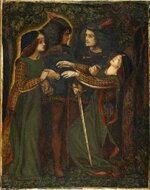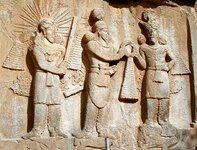DeepseekerADS
Gold Member
- Mar 3, 2013
- 14,880
- 21,733
- Detector(s) used
- CTX, Excal II, EQ800, Fisher 1260X, Tesoro Royal Sabre, Tejon, Garrett ADSIII, Carrot, Stealth 920iX, Keene A52
- Primary Interest:
- Other
Doppelgangers and the Mythology of Spirit Doubles - The Epoch Times
By April Holloway, Archaeology News on Human Origins, Ancient Places and Mysterious Phenomena | Ancient Origins | July 7, 2014
Last Updated: July 7, 2014 7:35 pm

"How They Met Themselves," the ink version, by Dante Gabriel Rossetti.
The universe is full of mysteries that challenge our current knowledge. In "Beyond Science" Epoch Times collects stories about these strange phenomena to stimulate the imagination and open up previously undreamed of possibilities. Are they true? You decide.
The mythology of spirit doubles can be traced back thousands of years and was present in many cultures of the past, holding a prominent place in ancient legends, stories, artworks, and in books by various authors. Perhaps the most well-known reference to spirit doubles or ‘alter egos’ is the doppelgänger, a word still used today to refer to a person that is physically or behaviourally similar to another person.
Doppelgänger is a German word meaning “double goer” and it refers to a wraith or apparition that casts no shadows and is a replica or double of a living person. They were generally considered as omens of bad luck or even signs of impending death – a doppelgänger seen by a person’s relative or friend was said to signify that illness or danger would befall that person, while seeing one’s own doppelgänger was said to be an omen of death.
Some accounts of doppelgängers, sometimes called the ‘evil twin’ suggests that they might attempt to provide advice to the person they shadow, but that this advice can be misleading or malicious. They may also attempt to plant sinister ideas in their victim’s mind or cause them great confusion. For this reason, people were advised to avoid communicating with their own doppelgänger at all costs.
One of the most famous depictions of doppelgängers comes from the 1851 sketch and 1864 watercolour called ‘How They Met Themselves’ by Dante Gabriel Rossetti. According to interpretation, two medieval lovers are walking through the woods at twilight when they encounter their doubles who glow supernaturally. The man draws his sword in astonishment, while his lover appears to collapse in a deathly swoon. Doppelganger imagery occurred in poems Rossetti admired such as Elizabeth Barrett Browning’s The Romaunt of Margaret and Poe’s Silence.

“How They Met Themselves,” the watercolor version, by Dante Gabriel Rossetti.
While Doppelgänger cases are said to be works of fiction, there are a number of real-life cases in which individuals claim to have met their sinister duo. Among the most noteworthy is Abraham Lincoln’s experience, as chronicled by Noah Brooks in his book Washington in Lincoln’s Time (1895). According to his account, soon after Lincoln was elected in 1860, he arrived home one day and looked into the bureau mirror where he saw himself reflected in double. Lincoln said, “…nearly at full length; but my face had two separate and distinct images.” Lincoln noticed that although the images were nearly identical, one was “a little paler—say five shades—than the other”. His wife was said to be very worried and told Lincoln she believed that the paleness of half the dual image was a bad omen, which meant that Lincoln would serve his first full term, but would not live to finish his second.
The subject of the double has a long history, particularly in literature. In Greek mythology Narcissus falls in love with his reflection, and in Gothic tales such as Edgar Allan Poe’s William Wilson (1839), James Hogg’s Private Memoirs and Confessions of a Justified Sinner (1824), Elizabeth Gaskell’s The Poor Clare (1856) and even Hans Christian Andersen’s lesser-read fairy-tale The Shadow, characters are haunted and followed by their often malevolent likenesses. However, the mythology of spirit doubles have far more ancient origins.
One of the earliest references may be in the Zurvanite branch of Zoroastrianism. This sect distilled the general abstract duality of Zoroastrianism into a concept of manifest twins “born” of a monist “Time.” In this cosmological model, the twins Ahura Mazda (Ormuzd) and Angra Mainyu (Ahriman) were co-eternal representatives of good and evil.

Investiture of Sassanid emperor Shapur II (C) with Mithra (L) and Ahura Mazda, ‘the good twin’ (R) at Taq-e Bostan, Iran. (Wikimedia Commons)
In Ancient Egyptian mythology, a ‘ka’ was a tangible “spirit double” having the same memories and feelings as the person to whom the counterpart belongs. In one Egyptian myth entitled, The Greek Princess, an Egyptian view of the Trojan War, a ka of Helen was used to mislead Paris of Troy, helping to stop the war.
Norse folklore describes entities known as vardøger, ghostly beings that preceded their living counterparts, taking their places at various activities and performing their actions in advance. The spirit with the subject’s footsteps, voice, scent, or appearance and overall demeanour precedes them in a location or activity, resulting in witnesses believing they’ve seen or heard the actual person before the person physically arrives. This bears a subtle difference from a doppelgänger, with a less sinister connotation.
People from the Orkney Islands in Scotland feared small, fairy-like creatures called “trows”. According to legend, trows would give birth to children who were apt to be sickly. Pregnant women were carefully guarded from the trows who would often steal healthy human babies and replace them with their own children, known as ‘changelings’, who would transform into exact replicas of the stolen children.
Many Native American creation myths likewise provide for the role of dualistic twins. Hopi legends refer to the twins who were called the Child of the Sun and the Child of the Water. The Hopi also believe in duality between the Upper World and the Underworld: that whatever is happening here in the Upper World, the opposite is happening in the Underworld.
So where did belief in spirit doubles come from and is there any real truth to them? While many today still believe in the existence of a double self, some scientists believe the phenomenon occurs based on injuries or stimulation to certain parts of the brain which cause errors in spatial reasoning. Others believe it is the result of a vision, hallucination, or that we live in a parallel universe in which everything in this world in replicated in another dimension. Whatever the real truth behind doppelgangers, belief in the spirit double has instilled both fear and wonder in people for thousands of years.
By April Holloway, Archaeology News on Human Origins, Ancient Places and Mysterious Phenomena | Ancient Origins | July 7, 2014
Last Updated: July 7, 2014 7:35 pm

"How They Met Themselves," the ink version, by Dante Gabriel Rossetti.
The universe is full of mysteries that challenge our current knowledge. In "Beyond Science" Epoch Times collects stories about these strange phenomena to stimulate the imagination and open up previously undreamed of possibilities. Are they true? You decide.
The mythology of spirit doubles can be traced back thousands of years and was present in many cultures of the past, holding a prominent place in ancient legends, stories, artworks, and in books by various authors. Perhaps the most well-known reference to spirit doubles or ‘alter egos’ is the doppelgänger, a word still used today to refer to a person that is physically or behaviourally similar to another person.
Doppelgänger is a German word meaning “double goer” and it refers to a wraith or apparition that casts no shadows and is a replica or double of a living person. They were generally considered as omens of bad luck or even signs of impending death – a doppelgänger seen by a person’s relative or friend was said to signify that illness or danger would befall that person, while seeing one’s own doppelgänger was said to be an omen of death.
Some accounts of doppelgängers, sometimes called the ‘evil twin’ suggests that they might attempt to provide advice to the person they shadow, but that this advice can be misleading or malicious. They may also attempt to plant sinister ideas in their victim’s mind or cause them great confusion. For this reason, people were advised to avoid communicating with their own doppelgänger at all costs.
One of the most famous depictions of doppelgängers comes from the 1851 sketch and 1864 watercolour called ‘How They Met Themselves’ by Dante Gabriel Rossetti. According to interpretation, two medieval lovers are walking through the woods at twilight when they encounter their doubles who glow supernaturally. The man draws his sword in astonishment, while his lover appears to collapse in a deathly swoon. Doppelganger imagery occurred in poems Rossetti admired such as Elizabeth Barrett Browning’s The Romaunt of Margaret and Poe’s Silence.

“How They Met Themselves,” the watercolor version, by Dante Gabriel Rossetti.
While Doppelgänger cases are said to be works of fiction, there are a number of real-life cases in which individuals claim to have met their sinister duo. Among the most noteworthy is Abraham Lincoln’s experience, as chronicled by Noah Brooks in his book Washington in Lincoln’s Time (1895). According to his account, soon after Lincoln was elected in 1860, he arrived home one day and looked into the bureau mirror where he saw himself reflected in double. Lincoln said, “…nearly at full length; but my face had two separate and distinct images.” Lincoln noticed that although the images were nearly identical, one was “a little paler—say five shades—than the other”. His wife was said to be very worried and told Lincoln she believed that the paleness of half the dual image was a bad omen, which meant that Lincoln would serve his first full term, but would not live to finish his second.
The subject of the double has a long history, particularly in literature. In Greek mythology Narcissus falls in love with his reflection, and in Gothic tales such as Edgar Allan Poe’s William Wilson (1839), James Hogg’s Private Memoirs and Confessions of a Justified Sinner (1824), Elizabeth Gaskell’s The Poor Clare (1856) and even Hans Christian Andersen’s lesser-read fairy-tale The Shadow, characters are haunted and followed by their often malevolent likenesses. However, the mythology of spirit doubles have far more ancient origins.
One of the earliest references may be in the Zurvanite branch of Zoroastrianism. This sect distilled the general abstract duality of Zoroastrianism into a concept of manifest twins “born” of a monist “Time.” In this cosmological model, the twins Ahura Mazda (Ormuzd) and Angra Mainyu (Ahriman) were co-eternal representatives of good and evil.

Investiture of Sassanid emperor Shapur II (C) with Mithra (L) and Ahura Mazda, ‘the good twin’ (R) at Taq-e Bostan, Iran. (Wikimedia Commons)
In Ancient Egyptian mythology, a ‘ka’ was a tangible “spirit double” having the same memories and feelings as the person to whom the counterpart belongs. In one Egyptian myth entitled, The Greek Princess, an Egyptian view of the Trojan War, a ka of Helen was used to mislead Paris of Troy, helping to stop the war.
Norse folklore describes entities known as vardøger, ghostly beings that preceded their living counterparts, taking their places at various activities and performing their actions in advance. The spirit with the subject’s footsteps, voice, scent, or appearance and overall demeanour precedes them in a location or activity, resulting in witnesses believing they’ve seen or heard the actual person before the person physically arrives. This bears a subtle difference from a doppelgänger, with a less sinister connotation.
People from the Orkney Islands in Scotland feared small, fairy-like creatures called “trows”. According to legend, trows would give birth to children who were apt to be sickly. Pregnant women were carefully guarded from the trows who would often steal healthy human babies and replace them with their own children, known as ‘changelings’, who would transform into exact replicas of the stolen children.
Many Native American creation myths likewise provide for the role of dualistic twins. Hopi legends refer to the twins who were called the Child of the Sun and the Child of the Water. The Hopi also believe in duality between the Upper World and the Underworld: that whatever is happening here in the Upper World, the opposite is happening in the Underworld.
So where did belief in spirit doubles come from and is there any real truth to them? While many today still believe in the existence of a double self, some scientists believe the phenomenon occurs based on injuries or stimulation to certain parts of the brain which cause errors in spatial reasoning. Others believe it is the result of a vision, hallucination, or that we live in a parallel universe in which everything in this world in replicated in another dimension. Whatever the real truth behind doppelgangers, belief in the spirit double has instilled both fear and wonder in people for thousands of years.






